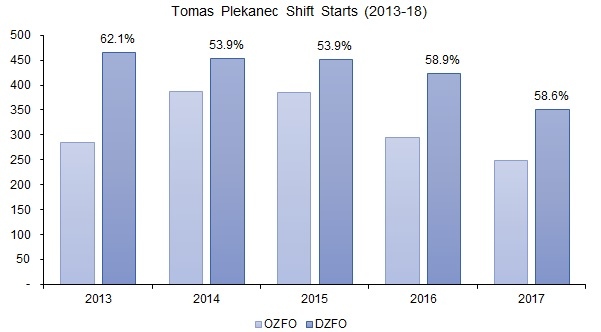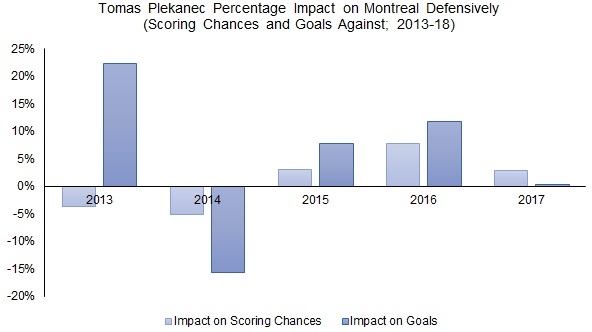Mar 1, 2018
Plekanec still delivers with his defence
Veteran centre brings the Maple Leafs a tremendous amount of value in the defensive zone, Travis Yost writes.
By Travis Yost

Lost in a flurry of big trades and even bigger non-trades was Toronto’s acquisition of veteran centre Tomas Plekanec from the Montreal Canadiens.
Five years ago, this would have been a front-page transaction. Plekanec was your prototypical two-way centre – a guy who would score 50 to 60 points a year and add a tremendous amount of value in the defensive zone.
But perception has changed over time. Some of this is simply due to the fact that Plekanec isn’t the scorer he once was. Last season, Plekanec had just 28 points in 78 games, which was comfortably a career low. This year, he has managed 24 points in 60 games – marginally better, but still not the type of numbers you would expect for a top-six centre.
It’s hard to tease out what’s hurt Plekanec here. On one hand, he’s 35 years old and has logged more than 1,000 NHL games played. Father Time catches up with everyone. On the other hand, it can’t help that he was playing for a truly dreadful Montreal team that hasn’t generated consistent offence in years. That shouldn’t absolve Plekanec for the lack of production, but it might help explain why there’s been such acceleration in the degradation of his counting numbers.
At this point in his career it’s probably safe to say that anything on the offensive side is found money. Toronto’s acquisition of him has much more to do with what he can do in the defensive zone, slowing down the opposition’s best attackers on a consistent basis.
Plekanec has never been given easy minutes. In a league where the vast majority of forwards are deployed in varying situations, Plekanec has become something of an exception. As just one measure, look at the percentage of shifts Plekanec as had to start in the defensive zone over the last five years – shifts where a best-case scenario saw Plekanec and his linemates simply winning back the puck and getting out of danger, and a worst-case scenario where Montreal is just firefighting to keep the puck out of the back of the net.

That’s a pretty reasonable disadvantage for Plekanec and whomever he was playing with. Given what we know about the beginning of defensive zone shift starts, it’s reasonable to assume that Plekanec’s raw defensive numbers might appear worse than anticipated because of the disadvantage he was put in. (Note: shift starts are just one way to consider deployment – items like ice time usage and teammate/opponent quality are also material to this discussion.)
But the interesting thing is that Montreal saw reasonably impressive defensive numbers with Plekanec on the ice. One thing we can do is look at scoring chance and goal against data to measure this (via NST). If Plekanec really is having an impact in the defensive zone we would expect to see that Montreal is materially better with him on the ice from either of these measures. Doubly so when you consider the fact that he’s not playing the easiest of minutes.
I looked over the last five years at the percentage variance between Montreal’s scoring chance and goals against performance at aggregate versus their scoring chance and goals-against performance with Plekanec on the ice. As you can see, Montreal almost always came out ahead:

What’s most noteworthy is that Plekanec has had a measurably positive impact on chances and goals alike in the last three years – three years where you would expect to see some age degradation start to creep into the mix. Over that stretch, Montreal’s been about 5 per cent better combating scoring chances and 7 per cent better combating goals with him out there. That’s a pretty respectable impact. As a brief aside, I’m not sure I can explain what happened in 2014-15 outside of sheer randomness, poor luck, or simply some variable I can’t today explain – those numbers simply don’t align with Plekanec’s historical career arc or recent performance data.
Bringing this together, you can start to see why Toronto targeted Plekanec in a trade. Everyone knows the Maple Leafs can score – usually at will – but they do run into trouble on the defensive side. And Mike Babcock is notorious for his adoration of quality checking-line centres, so I suspect this is going to be a match made in heaven.
For Toronto, it gives them a wrinkle they didn’t exactly have in spades before the trade deadline – a checking line at the bottom of the lineup that can soak up tough minutes and chip in from time to time in the offensive zone.
In a league where you simply can’t roll out less than four competent lines come playoff time, it’s a trade that makes an awful lot of sense for a Leafs team with big aspirations this spring



